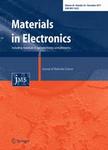版权所有:内蒙古大学图书馆 技术提供:维普资讯• 智图
内蒙古自治区呼和浩特市赛罕区大学西街235号 邮编: 010021

作者机构:Int Islamic Univ Dept Elect & Comp Engn Islamabad 44000 Pakistan Int Islamic Univ Ctr Adv Elect & Photovolta Engn CAEPE Islamabad 44000 Pakistan King Abdulaziz City Sci & Technol Riyadh Saudi Arabia Jouf Univ Coll Comp & Informat Sci Sakaka Saudi Arabia
出 版 物:《JOURNAL OF MATERIALS SCIENCE-MATERIALS IN ELECTRONICS》 (J Mater Sci Mater Electron)
年 卷 期:2025年第36卷第2期
页 面:1-26页
核心收录:
学科分类:0808[工学-电气工程] 08[工学] 0805[工学-材料科学与工程(可授工学、理学学位)] 0702[理学-物理学]
主 题:Nanocomposites
摘 要:Wearable self-healable strain sensors are gaining significant attention for applications in healthcare, robotics, and human-computer interaction. However, existing sensors face key challenges, including limited healing efficiency, low sensitivity to mechanical strain, and inadequate durability under repeated stress. Addressing these limitations, this study presents a novel strain sensor combining a polyurethane (PU) substrate with magnetic iron oxide nanoparticles (MIONPs) and silver flakes to enhance self-healing capabilities and strain sensitivity. The integration of MIONPs enables a self-healing efficiency of 96.6% within 24 h, a notable improvement over previous technologies that often require longer recovery times and achieve lower healing rates. Additionally, the sensor achieves a high gauge factor of 271.4 at 35% strain, representing a fourfold increase in sensitivity compared to traditional strain sensors. The sensor s responsiveness to external magnetic fields, with a magnetic sensitivity of 0.0049 T(-)1, further expands its application potential in areas like magnetically controlled devices and soft robotics. This work significantly advances multifunctional, self-healing strain sensors by addressing current limitations and offering improved performance for long-term, sustainable applications.